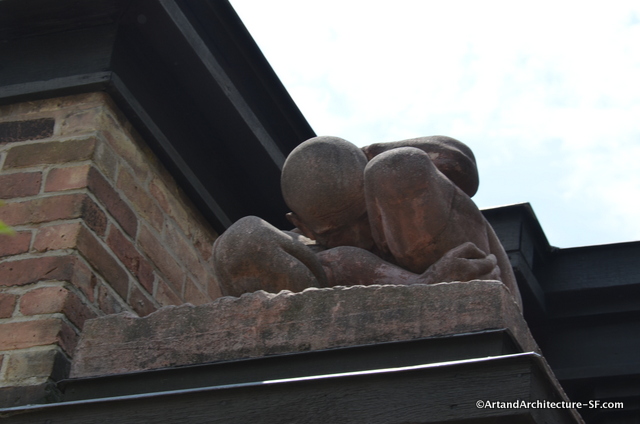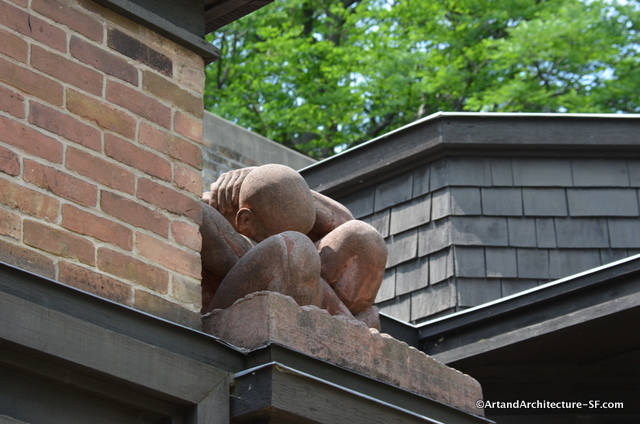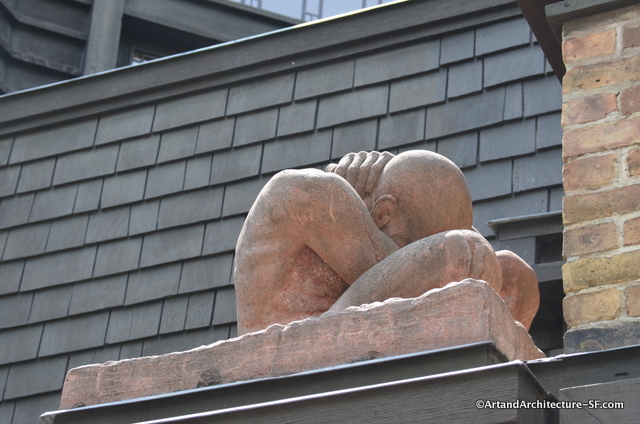951 Chicago Avenue
Oak Park, Chicago
 On the piers flanking the entry to Frank Lloyd Wrights 1898 architectural studio in Oak Park, Illinois, sit these two pieces, designed by Frank Lloyd Wright and executed by Richard Bock.
On the piers flanking the entry to Frank Lloyd Wrights 1898 architectural studio in Oak Park, Illinois, sit these two pieces, designed by Frank Lloyd Wright and executed by Richard Bock.
“Boulder Man” is the most valuable of Richard Bock’s work. He originally designed and modeled the piece to top a gate post. The body, apparently half buried in the earth is stunning from every angle. These sculptures are reproductions. They were re-created from photographs. The originals had disintegrated beyond repair, the replicas were done during the 1980s restoration of Frank Lloyd Wrights home and studio.
The story goes that Wright wanted two sculptures, but could only afford one. To get reflecting sculptures, i.e. a right and a left, two separate sculptures must be made and then two separate molds and final castings, so he simply turned one of them to a different angle, giving the sense of two different sculptures.
Richard Bock was born 1865 in Schloppe, Germany. He moved to Chicago, with his family as a youth, where he grew up in German neighborhoods.
 Bock spent three years at the Berlin Academy studying and later at the Ecole des Beaux Arts School in Paris. In 1891 he returned Chicago to establish a permanent sculpture studio. Almost immediately upon Bock’s return to America, he received three major commissions and for the World’s Columbian Exposition in 1893, he sculpted major architectural works for the Mining and Electricity Exposition Halls.
Bock spent three years at the Berlin Academy studying and later at the Ecole des Beaux Arts School in Paris. In 1891 he returned Chicago to establish a permanent sculpture studio. Almost immediately upon Bock’s return to America, he received three major commissions and for the World’s Columbian Exposition in 1893, he sculpted major architectural works for the Mining and Electricity Exposition Halls.
He created interior bas-reliefs for Chicago’s Schiller Building, during which time, in the winter of 1891 to 1892, Bock studied under its architect Louis Sullivan. It was in the Sullivan’s office that Bock met Frank Lloyd Wright.
From 1903 to 1913, Bock worked almost exclusively with Wright on multiple projects, The two became close friends and their families often spent time together.
The close working relationship came to end when Wright invited Bock to accompany him to Japan. Bock, a family man, declined. Though they remained friends they were never worked together again or visited much afterwards.
In 1929, Bock became the head of the Sculptural Department at the University of Oregon, he retired in 1932.
In the 1940s, Bock and his wife moved to California where in 1949 he died at the age of 84 of Parkinson’s Disease.
